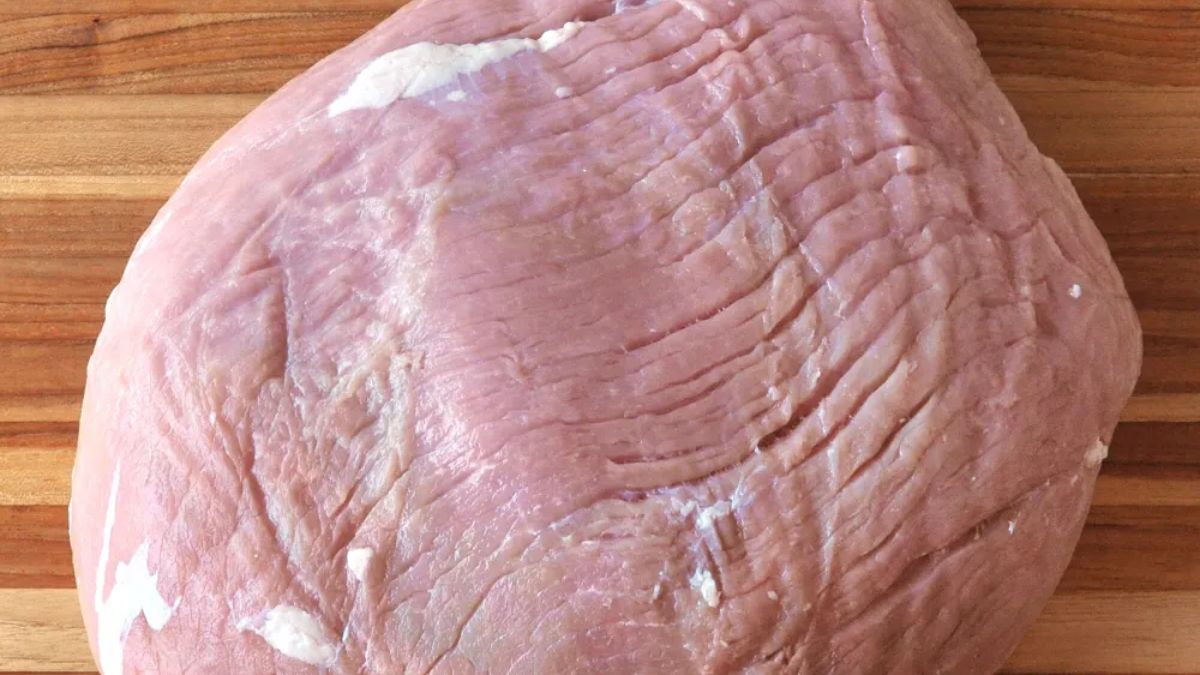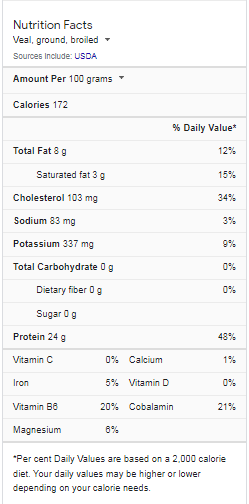Veal is meat from calves that are usually between 6 and 8 months old but can be much younger. Most veal calves are male Holstein-Friesians. Since they can’t make milk, the dairy industry sells them to be slaughtered for profit. Veal is a popular cut of meat in Europe, and about 82% of the world’s Veal comes from the E.U.
The meat is rarely eaten in the U.K. and U.S., where the number of people who eat Veal has decreased since the 1960s. It used to have a bad name for being cruel, and farmers in the U.K. and the U.S. have worked hard to change that. Even though some national veal industries have been changed, veal production is still cruel. Veal is a moral risk beyond just buying the meat because it is closely linked to dairy.
Veal Nutrition Facts
What is Veal?
Veal is the meat from a male calf aged 16 to 18 weeks old. It is not fed any grains or grasses, which gives its meat a delicate texture and a creamy pale color with a grayish-pink hue. On the other hand, beef is the darker red meat from older animals. The age and the way the young calves are fed make a difference in the meat. Bob veal is the meat from calves up to 1 month of age. Milk-fed Veal from calves up to 12 months old is more delicate than Veal from formula-fed calves up to 4 months old.
Veal is meat from young calves, usually bull calves from dairy herds, that can’t be used to make milk. There are two kinds of Veal. “White veal” is known for being pale and tender, mostly due to the calves’ limited diet and lack of exercise. However, since crates have been banned, calves move around a lot more. They make “rose veal” darker but still tender because the calves can move around and access a healthy diet. Instead of its mother’s milk, the calf is usually fed milk powder, calf replacer pellets, and forage (in the case of rose veal).
In Australia, Veal is the meat from dairy calves that weigh less than 70kg or beef calves (called “weaners” or “vealers”) that weigh up to 150kg. Calves from the dairy industry can be pure dairy breeds, like Holsteins, or breeds that mix dairy and beef, like Holsteins and Angus. When calves are taken away from their mothers, they usually grow up on farms that specialize in raising calves unless the dairy farmer has facilities for raising calves. Calves are usually raised in groups in sheds (though some have access to pasture) and fed milk or milk replacer and then a grain-based diet. With this special way of raising calves, the meat is pink and is called “rose veal.” Beef breeds called “vealers” or “weaners” are raised on pasture with their mothers. The Veal from a calf raised this way is a light red color.
Veal Crates
Australia has never used a method of making Veal in which calves spend their whole lives in individual crates with solid wooden sides that don’t let the animal turn around or act naturally. This cruel way of housing calves to make Veal is meant to make the “classic” white-colored Veal by keeping the calves from getting iron. Since 2007, veal crates have been against the law in the U.K. and Europe, but they are still used in some places.
Is Veal Cruel?
Most “white veal” comes from the E.U., but not the U.K. In the E.U., veal calves are usually kept in closed barns with slatted floors, without bedding, and with little or no fiber in their diet. But in the U.K., calves raised for Veal are usually kept in straw barns with natural light, fed a good diet, and some even have access to pasture. Because of these differences, the lives of U.K. veal calves are better than those of E.U. veal calves. Under RSPCA Assured, this is made even better by strict rules about how much milk is fed, how long the environment is changed, and how much space is given.
Getting Veal is the same thing as hurting young cattle. Calves are taken away from their mothers and their natural food source (cow’s milk) and only live for a short time of their normal lives. These calves also live in a small space to get tender meat for Veal.
Why is Veal White?
Most of the time, the U.K. doesn’t make white Veal. Most white Veal comes from calves raised on the continent killed before they were eight months old, usually between 20 and 24 weeks. During this time, all they eat is fortified milk and solids, which don’t have much fiber and are low in iron, making them look white (due to anemia). There are concerns about the welfare of white Veal. If you want to eat Veal with a higher level of welfare, you should ask for RSPCA Assured Veal or at least rose veal from the U.K.
What are the Different Cuts of Veal?
- Chops of Veal come from either the loin or the rib, and they taste best when they are grilled, roasted, or broiled.
- The veal shank comes from the hind shank, the leg bone below the knee, and above the shoulder. Most of the time, the veal shank is cut to show a cross-section of the shin bone. Braised veal shanks from Italy, called Veal Osso Bucco, are a popular way to cook veal shanks.
- Cutlets of Veal are thin slices from the leg that are about 14 inches thick. They taste best plain or breaded and fried.
- The thymus gland and pancreas of young calves make up veal sweetbreads. They go bad quickly and need to be soaked before being cooked.
- Veal scraps are used to make ground veal. Since it is very lean, it is usually mixed with other ground meats, like pork or beef.
Is Veal Just Baby Cow?
Veal comes from male calves, which are young cows killed when they are only a few months old. Male calves in the dairy industry don’t have a good future, and they are often killed within hours of being born or sent to veal crates, small plastic huts with just enough room for a calf to stand. Veal is meat from young calves, while beef comes from older cattle. Veal can come from a calf of either gender or any breed, but most of it comes from young male dairy breed calves that aren’t used for breeding. Most of the time, Veal costs more per pound than beef from older cattle.
Is Veal Good for Steak?
Veal is just young beef that has been processed like a lamb is young sheep. Because the animal’s muscles aren’t very strong, it’s very tender. (Caging the calves makes the meat more tender, but processing them before they get big enough to work their muscles also makes the meat more tender. Veal is slightly more tender than beef because its muscles aren’t worked as hard. It also has a much lighter flavor than beef. Because Veal is much more tender than beef, it is easier for our bodies to break down.
Does the RSPCA have Animal Welfare Standards for Dairy or Beef Calves?
The RSPCA’s certification program for farms is called the RSPCA Approved Farming Scheme. It focuses on the well-being of animals.
The RSPCA’s standards for dairy calves are mostly about making sure that good farming, handling, care, and management are used. Calves on farms that the RSPCA approves have room to move, play, and meet other calves. They should have a good, healthy diet, good bedding, and be able to go outside when they are at least eight weeks old. So far, the RSPCA Approved Farming Scheme does not include any farms that raise calves for Veal.
With the release of the RSPCA’s standards for dairy calves, the organization encourages farmers to raise calves for Veal or dairy beef to higher welfare standards. Demand from consumers could help cut down on the number of bobby calves used as waste products in dairy farming. Find out what it means for dairy calves to be RSPCA-approved.
There isn’t an RSPCA-approved dairy veal or dairy beef product on the market yet, but the RSPCA has been talking to farmers and people in the business world. This is what you can do to help:
- Contact your favorite veal brands and tell them that you care about animal welfare.
- Please write to your grocery store and tell them you want Veal or dairy beef raised in a better way for animals.
What Dishes are with Veal?
How do you Eat Veal?
It’s tender but very lean, so it goes best with another meat to cut with more fat, like beef or pork with 20 percent fat. Use it in burgers, meatloaf, or bolognese. Veal chops have the bone still in them and are thick and meaty. You can broil, roast, or grill them. Chops and steaks of Veal are best when they are grilled or broiled. Veal stewing beef tastes great when it is braised or stewed in liquid.
Small amounts of liquid are good for braising veal breast, shoulder roasts, and blade steaks. Veal is a special food that has been eaten since the Bible and is highly prized in the cuisines of many European countries. Traditional dishes from France, Austria, and Italy include blanquette de veau, Wiener schnitzel, and saltimbocca. But Americans don’t eat much Veal—about a third of a pound per person.
Conclusion
Veal is meat from a young animal, either a dairy breed, a cross between a dairy breed and a beef breed, or a beef breed. Dairy and dairy crossbred calves are taken away from their mothers and raised on veal farms, while beef breed calves are raised with their mothers and taken away from them when they are older. A young male calf raised for its meat is called Veal.
Traditionally, veal calves are a byproduct of the dairy industry. Since they can’t produce milk, they are raised separately for their lean and tender meat, which chefs and foodies have long loved. But D’Artagnan veal is different. It’s a whole new way to look at Veal, and it comes from cattle breeds known for producing high-quality meat, not milk. Read on to learn more about the five things that make our Veal different from all other Veal in the world.



